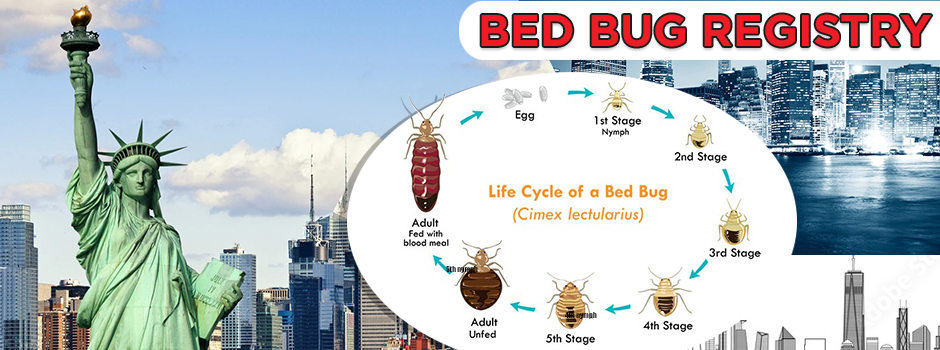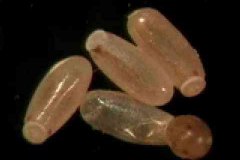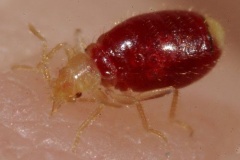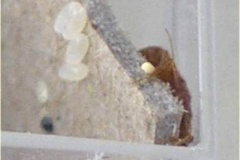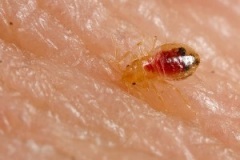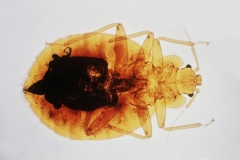Let's get one thing straight: bedbugs are simply not the scourge most people think they are for budget travelers and backpackers. Bed bugs don't transmit disease and hostels don't harbor them any more than hotels do (and outbreaks in either place are very rare). You're far more likely to get bed bugs in a hotel in New York City than you are on a backpacking trip to Southeast Asia.
In this article, I'm going to lay some myths to rest whilehelping you learn how to identify bed bugs, showing you which signs you should look out for in your accommodation, cover how you can effectivelytreat bed bug bites, help you toavoid bedbugs as you travel, and sharehow to kill them if they decide to travel with you (they're frustratingly tricky to get rid of).
I'll start with the myth-busting first.
Let's start first by saying that hostels have no more bed bug incidents than do other accommodation options. Greg Baumann, vice president of technical services at National Pest Management Association says,"There are no data to support that hostels have a higher incidence of bed bugs (than hotels)." Nonetheless, some people will always fear hostels are bed bug hotbeds. If you're one of those people, I can highly recommend traveling with a silk sleeping liner for peace of mind.
In the early 2000s, bed bugs became a hot travel topic when they started turning up in some luxury hotels. They had virtually disappeared from the U.S. lodging scene until a 1972 DDT insecticide ban; the spray once used on cockroaches and other pests turned out to have been an effective way to kill bed bugs, too. After DDT was banned, the number of bed bugs drastically increased.
In Europe, the bugs never really left.
Canada's Pest Control writes of bed bug hotel infestations: "The stigma attached to these parasites is influencing some hotels and other accommodations to ignore infestations or treat them without professional help. Lack of professional treatment comes with great risks, notably the possibility of litigation." Reading between the lines, we can deduce that there's no way in Hades some hotels will agree that those red bumps on your body are bed bug evidence -- and a U.S. desk clerk may not even know what bed bug bites really look like, anyway.
The lesson here is to do your research beforehand -- that's what this article is for!
Hostels, on the other hand, have long acknowledged the bugs' presence in the lodging world, especially outside the United States, and many take steps accordingly. Some actively tell you what to look for, and some hostels don't allow sleeping bags in hostel dorms, partly because yours can carry bed bugs (they like traveling as much as you do). Bed bugs also hitchhike on backpacks, which should tell you how easily they can be spread. If you manage to get bed bugs and don't realise for a week, you could have transported them to three different hostels and into twenty backpackers' bags, who have then each travelled to three other hostels.
Many people assume the bugs come with the territory of filthy hostels (another myth -- that all hostels are filthy by nature). Bed bugs don't care about a clean environment, though.
Where some truth may lie in the hostels-always-have-bedbugs myth is that the sheer density of people possible in one hostel dorm room(I've come across dorm rooms that sleep 100people at once!) can create a higher possibility of the bugs' appearance than in a hotel room used by a couple of travelers at a time.
If twelve backpackers are sleeping in one room, twelve chances are created for bugs to hop off one backpacker's stuff and onto yours, or into the hostel dorm furniture.
Again, though, there is no evidence to support the idea that hostels are more prone to infestation than other lodgings; in fact, given the higher likelihood of infestation and bed bug transference in a hostel because of sheer traveler numbers, it's remarkable that that likelihood does not translate into an actual higher infestation incidence in hostels than hotels.
I've been traveling the world full-time for over sixyears now, have stayed in literally hundreds of hostels, and have only been bitten by bedbugs once. It's a very rare occurrence.
And when I did get bitten? I told the hostel and they threw out all of their bunkbeds and bedding, and completely replaced them in order to make sure they were truly gone.
That's a far better response than refusing they didn't exist in the first place.
Do bedbugs carry disease? Well, bedbugs do carry 24 known pathogens, but do bedbugstransmit disease? Nope,bed bug biteswon't make you sick (unless, of course, the bites get infected). And while bedbugs do feed on blood, they don't spread AIDS or other blood-borne illnesses. In other words, if you're bitten by bed bugs, the only things you need to worry about are not scratching the bites until they bleed and finding a way to control the itching.
Mosquitos, on the other hand, can carry plenty of nasty diseases,likemalaria, dengue,and West Niledisease, which they transmit to you via a science fiction-like needle nose. If you're going to worry about one type of critter while you're traveling, make it mosquitoes.
That's not to say bedbugs and bed bug bites aren't a pain to deal with. They definitely are.
Bedbugs are gross, no doubt about it. Thinking about creatures crawling around in your bed and drinking your blood is a real shudder inducer. That actually happens all the time, though -- the creatures looking for your blood, that is (think mosquitoes). It might be the fact that bedbugs kindascuttlethat make them seem especially awful, and bed bugs are nocturnal -- creatures that scuttle at night just seem particularly sneaky, despite having microscopic brains and no personality characteristics to speak of.
The presence of bedbugs in a hostel or hotel don't mean the placeis unsanitary, though. Cockroaches, ants, flies -- yeah, they all love old food. Bedbugs likefreshfood. A dirty hostel does not attract bedbugs simply by virtue of its grime -- that's not how these travelers pick their new destinations.
The bedbugs hitchhike into hostels, hotels and, eventually, your own house, by way of your stuff -- your clothes, your sleeping bag or your backpack. They grab a ride out the same way.
As Baumann says of unsanitary conditions, "Bedbugs don't really care about that, and can be in the fanciest of hotels all the way to the other end of the spectrum." He goes on to say that while the whole bedbug infestation, cleanliness-impaired hotel equation is popular, there is no data to support it.
The single connection that could be possibly be made between the bugs and unsanitary habits would be that abedbug killing recommendationis washing possessions in very hot water. Perhaps that's how the myth started -- but no one, anywhere, ever washes their curtains in boiling water every day in order to keep a clean house. (Do they?)
Now that we've covered the myths, let's get stuck into what to look out for.
A bed bug bite looks like a small welt, and it burns and/or itches like crazy. And I mean, itchy.I've never experienced anything like it!
You can't feel a bed bug bite while it happens (they take about five minutes to feed), and the bugs are nocturnal. You'll typically wake in the morning feeling strangely itchy and look down to discover you're covered in red bites.
One distinguishing feature of bed bugs bites is that they often appear in a row of three. People will joke that when they bite you, they go for breakfast, lunch, and dinner while they're there! When I was bitten, the vast majority of mine were in groups of three, but some were spread out and others were in clusters, so don't assume it's something else if your bites aren't all in lines of three.
If you're wondering if yours is a bed bug bite, a quick search on Google Imageswill bring up some examples you can compare yours to.
You should wash a bed bug bite with soap and water, apply some ice, and use an antihistamine cream or no-itch cream. (Do check out Brave Soldier antisepticcream. It's the best no-itch, no infection, no-scar wound treatment around. Read aBrave Soldier reviewand then consider letting Brave Soldier guard your borders -- I always carry a tube in my travelfirst aid kit.)
The most important thing here is not. to. scratch. These bites areitchy and the more you scratch them, the more likely it is that they'll become and open wound and get infected.
If a bed bug bite gets infected while you're traveling (gets very tender, feels hot, and starts oozing yellow, white or greenish goo), you should consider seeing a doctor. I've seen doctors abroad when I'm sick -- it's been easier and less expensive for me than seeing U.S. doctors, and I got well every time. If you're not able to see a doctor and are traveling with antibiotics, consider taking a course if you're 100% convinced it's an infection.
Bedbugs are teeny flat critters; grown adults are about the size of an apple seed. Adults are brown until they consume some blood, after which they turn reddish brown. Ah, that rosy after-dinner glow.
Pinhead-sized nymphs, or non-adults, are smaller and are whitish or gold until they feed -- just about the color of a mattress, making them very tough to see. (More evidence of clever, sneaky behavior.)
Bed bugs like beds, of course, though "bed bug" is actually a misnomer, since they certainly live anywhere. However, they're especially likely to like your bed -- you, who are their meal ticket, are in bed all night, which is when they come out to eat.
According to the National Pest Management Organization, the bugs can also live in carpets, under wallpaper, behind baseboards, and in small cracks and crevices throughout a room. Baumann comments that the bugs can be found in all furniture, pointing out that someone carrying them in clothing can spend as much time on couches and chairs in the living room as in bed.
The bugs can travel alone, but seeing one is probably the tip of the iceberg. The nocturnal animals are transient and elusive. They can hide in the seams of mattresses or in the heads of screws, which makes them particularly tricky to track down. I've even heard of bedbugs crawling up onto the ceiling and falling down onto a bed to feed at night.
They're so frightening because they're so hard to find.
The odor of an bed bug infestation, though distinct, is too subtle for amateur bug detectives. Bed bugs are said to smell like sweet, rotten raspberries, and it's also said that an infested room smells like almonds; I can't summon up that particular odor mix, but perhaps you'll catch the smell of an old granola bar if you flatten a scuttler and know that, yep, it was a bed bug. Most likely, you'll need a biginfestation before you can smell the bugs in a room's air.
Bed bugs do leave tiny reddish or black streaks on sheets. If you see those upon checking into a hostel orhotel room, consider grabbing your stuff before crawling hitchhikers hop on it, and cruising straight back to the desk to ask for a new room.If need be, just go to adifferent hostel or hotel-- cheaper than getting rid of the pesky travelers if they hitch a ride with you, and far better than being bitten all night. The staff should offer you a refund, of course.
These bugs are great world travelers. They like living in yoursleeping bag, backpack, and clothes until they can get to your house and move into the recliner, where they can start raising a big family in a nice neighborhood. A female can lay up to 500 eggs over its lifetime. Take a look in the seams of your backpack or along the zipper to spot them in a likely destination. And if you suspect you might have an infestation, do not take your backpack into your home. You'll likely have to spend thousands of dollars to get rid of them if that happens.
Let's look at some of the bugs' habits before learning about how to kill bed bugs.
The bedbugs hitch rides in baggage, sleep sacks, or sleeping bags. They jump from hotel to hostel to home on humans -- someone brought 'em to your lodging, albeit accidentally. And they all want to be exchange bugs and travel to new homes internationally.
You'll likely noticebitesbefore, andif you see the biters themselves, unless you see thetelltale streakson your sheets; the bugs are nocturnal and they hide out unless feeding.
And they're tough customers. They can live more than a year without eating; taking a vacation in hopes the bugs will then move out won't work. They can take the temperatures, too; the bugs are okay with boiling to Fahrenheit 113, and freezing will rarely kill them either.
If you've gotbites, or you know you've spent time in a room harboring the bugs, vacuum your suitcases, backpack, camera bag -- leave no seam unsucked. Wash everything you own in the hottest water possible to boil the little biters. When I got bed bugs, I asked the hotel I was staying at if they would be able to wash my backpack and everything in it in their large laundry machines, then used the hair dryer on everything I owned afterwardsto be sure they were gone. I even used the hair dryer on every page of my diary!
The same rules on how to kill bed bugs while traveling apply at home: vacuum your living space relentlessly, including furniture, changing the bag outside (small bed bugscan wiggle through a stitch hole). Wash or dry clean everything moveable (clothes, bedspreads, throw rugs) in hottest water. If one happy couple escapes, though, it's all for nothing.
Baumann points out that people pay plenty trying various home remedies that don't go so well, and recommends that you bite the bullet and foot the bill for an exterminator to begin with. It's easiest, fastest, and most likely cheapest in the long run.
The exterminator will have instructions regarding jobs you should complete prior to his arrival. They'll be things likedon't open travel bags on home furniture, like beds, and store them away from furniture (like in an outside shed), so any bugs who've hitchhiked may not get the chance to move in.
You may have to also:
You may also want to:
The bugs now live in all 50 states -- you can certainly get them at home without having traveled, too. Craft says Orkin has exterminated the bloody beasts in all states but North and South Dakota.
Once the mass slaughter is over and you're bug free, don't let the bugs bite again by keeping an eye out for the little pests next time you travel, and use the tips above to keep them out of the house when you get home.
This article has been edited and updated by Lauren Juliff.
Follow this link:
Everything You Need to Know About Bedbugs and Travel

 Residence
Residence  Location
Location 
